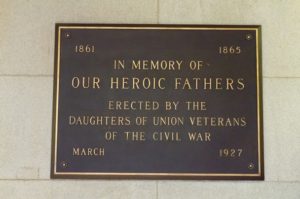FUNDING CUTS IMPACT CT HUMANITIES: Help CT Humanities navigate recent funding cuts and continue our vital work across Connecticut. All donations made to CTH will be matched dollar-for-dollar up to $50,000. Donate today!
Now Viewing:
Civil War Monuments at the Capitol

The 29th First to Enter Confederate Capital When It Surrenders – Today in History: April 3
On the morning of April 3, 1865, the 29th (Colored) Regiment Connecticut Volunteer Infantry awoke to find that the enemy had abandoned their positions in Richmond, Virginia.
Read
A Memorial to General Hawley at the State Capitol
Although not a native of Connecticut, one would be hard pressed to find a man more committed to the people of Connecticut than Joseph Roswell Hawley. He became Brigadier General of the 1st Connecticut Infantry during the Civil War and served the state as both a senator and as Connecticut’s 42nd governor. Within months of his death, the Connecticut legislature authorized construction of a memorial in his honor.
Read
A Monument Memorializes the Fallen
In front of the state capitol is a mortar commemorating the service of the First Connecticut Heavy Artillery Regiment. The mortar may or may not be the original “Petersburg Express” used at the famous siege of Petersburg, Virginia, during the Civil War.
Read
Remembering Civil War Prisoners of War
Outside the Connecticut State Capitol building in Hartford stands a monument to the Connecticut prisoners retained at the Andersonville Prison during the Civil War.
Read
Hall of Flags: Memorial to Connecticut’s Civil War Colors
Battle flags played an important strategic and ceremonial role in Civil War battles. The preservation of Connecticut’s Civil War colors has been a long, delicate, and expensive process.
Read
Gun Wheel of the First Light Battery, Connecticut Volunteers
A wheel damaged in battle now resides at the Connecticut State Capitol to commemorate the Civil War service of the First Light Battery Connecticut Volunteers.
Read
Sloop-of-War Ship’s Figurehead Lands at State Capitol
A figurehead from the USS Hartford currently resides at the Connecticut State Capitol and serves as a reminder of the state’s rich maritime heritage.
Read
The Ulysses S. Grant Memorial Tablet
The Connecticut Division of the Sons of Veterans, USA, commissioned a memorial tablet to Ulysses S. Grant who led Union forces during the Civil War.
Read
Connecticut’s Chickamauga Tree: An Investigation
The Connecticut State Capitol displays part of a tree with a cannonball lodged in it. While it is believed to be a remnant of the battle at Chickamauga Creek during the Civil War, evidence exists suggesting the artifact may have been fabricated for the purpose of commercial sale.
Read
Connecticut’s Capitol Building – Inside and Out
The Connecticut State Capitol was built at a time when Civil War commemoration was gaining popularity.
Read
The Gettysburg Address and Heroic Fathers Bronze Tablets at the State Capitol
In 1927, two different women’s organizations dedicated plaques to commemorate events and service in the Civil War.
Read
Honor and Duty: The Life of Alfred Howe Terry
Born in Hartford, Alfred Howe Terry studied law before heroically capturing Fort Fisher during the Civil War.
Read
Connecticut’s War Governor, William A. Buckingham
Connecticut governor William Buckingham’s bronze statue at the Connecticut State Capitol honors his guidance of Connecticut through the Civil War.
Read
Civil War Monuments and Memorials in and Around the State Capitol
Monuments and memorials from the Civil War era in and around the state capitol in Hartford, Connecticut.
Read
The Forlorn Soldier Statue
The Forlorn Soldier statue survived years of neglect, punishing weather, and efforts to tear it down.
Read
Commemorating the USS Hartford at the Connecticut State Capitol
The Connecticut State Capitol currently houses two important artifacts to commemorate the service of the USS Hartford.
Read
Pomp and Circumstance: Civil War Commemoration
The completion of the Forlorn Soldier did not meet with the pomp and circumstance of many other CIvil War commemorations, despite its media coverage and an overflowing sense of nationalism among the general public.
Read
Gideon Welles’s Role in Lincoln’s Cabinet
Earning the trust of Abraham Lincoln, despite reservations from many in Lincoln’s cabinet, Gideon Welles navigated the Union navy through the Civil War. He did this largely through expanding the navy and investing in new technology, such as ironclad ships.
Read
James G. Batterson, Stone Contractor
James G. Batterson was an artist, inventor, and businessman. He helped commemorate the Civil War through his proficiency with stone.
Read
The 29th Regiment Connecticut Volunteer Infantry Flag and Display
Regimental flags played important symbolic and strategic roles in battle. The State of Connecticut maintains a collection of 110 such flags from the Civil War, among them, the flag of the 29th (Colored) Volunteer Infantry.
ReadMore Articles




